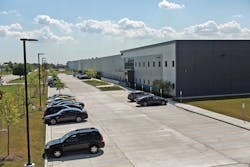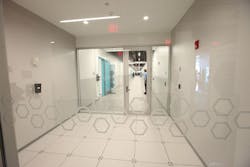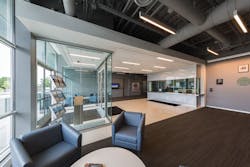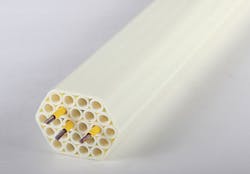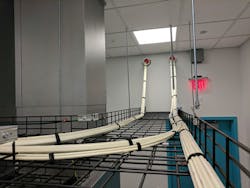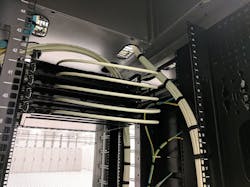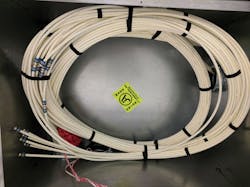By Larry Johnson, Light Brigade Inc.
Each day the internet bombards the media and IT industry sites with news of technology advancements and innovations, such as the latest emerging software, a new WiFi router product enhancement, or a cool mobile app. Rarely, if ever, can IT or network managers recall news of a reinvention, a transformation, of a network infrastructure that redefines it into something that never quite existed before, creating an entirely new category. Why is it so rare? It takes ingenuity, keen business acumen, technology and infrastructure design expertise, and a game-changing vision.
By reinventing both the typical data center colocation business and technology models, Forsythe Data Centers (datacenters.Forsythe.com), a business entity of Forsythe Technology Inc. (www.Forsythe.com), created a powerhouse of newly discovered cost savings, new data center efficiencies, unrivaled security, and unique customer services and benefits in its Elk Grove Village, Greater Chicago, IL location.
In May 2015, Forsythe launched its bold vision-the industry’s first data center facility offering truly private, secure and cloud-ready data center suites with individual client-controllable suite infrastructure. Based on its Retail+ business and technology model, Forsythe’s unprecedented client offering combines the flexibility and modularity, size, and shorter contract length of retail data centers with the privacy, client-controlled security and power, high density, and freedom of choice associated with wholesale data centers. Literally, clients have the ability to grow from a single cabinet to a 300-square-foot private mini-suite to their own 1,000- to 4,000-square-foot data center within a data center. Each 1,000+ square-foot suite also has an accompanying 670-square-foot support room for precision N+1 air conditioning and 2N uninterruptible power supply. Moreover, the Forsythe facility equips clients with a breadth of professional services and resources that allow them to plan, build, house and manage their personal data centers and entire IT environment under one roof.
Using an air-jetted fiber system, Forsythe Data Centers derived cost savings, data center efficiencies, security, and unique customer services at its Elk Grove Village, IL location.
With 45 years of Forsythe Technology IT integration expertise, Forsythe Data Center integrated the latest technologies into its new facility, such as cloud computing and virtualization, and expanded compute capacity for customers vertically rather than horizontally yielding fewer cabinets and a smaller footprint, yet with more power density than typical data centers. The result was 700-percent greater rack space utilization and 4 times the processing performance, potentially saving millions of dollars over time for its clients and greatly reducing the center’s capital and operational costs.
Another crucial, advanced technology integrated into the facility and positively impacting Forsythe’s reinvention of the typical data center business and technology models is the air-jetted fiber infrastructure system innovated by the Dura-Line (duraline.com) and AFL (AFLglobal.com) companies. This air-jetted (blown fiber) infrastructure technology enhances the Retail+ model, as well, by providing its own game-changing and surprising benefits to both Forsythe and its clients-benefits difficult to attain with a conventional optical fiber infrastructure. One such surprising benefit is the technology’s ability to blow fiber into a new client suite in an unprecedented 20 minutes, a service unequaled in data center colocation.
Some of the many other benefits of the Dura-Line and AFL air-jet technology include continuous fiber runs throughout the facility with zero points of network failure, virtually unlimited fiber and bandwidth capacity, real-time futureproofing, no end to the fiber lifecycle, only two installers, up to 90 percent savings in time and labor for fiber installs, and much more.
Meeting the needs of Forsythe clients
Forsythe’s client base, many of which are typically already tech-savvy, consist largely of financial institutions, healthcare providers, retailers, manufacturers, educational institutions and the many organizations that rely on immediate and reliable access to data to serve their own clients. They are seeking advanced solutions in a hybrid cloud environment, expecting full advantages generated by both the private and public cloud. Their needs and expectations for hybrid cloud, plus their wish list for other benefits include the following.
- Flexibility to customize their data center suite quickly and easily
- Scalability to migrate from 10, 25, 40, 100 and 400 Gigabit Ethernet speeds
- High security
- Hybrid cost efficiencies, such as curbing capital expenditures and energy costs
- Speed of data center setup and subsequent moves, adds and changes (MACs)
- No attenuation loss for optimal transmission
- Zero downtime
- Futureproofing
- Protection of the fiber and easy cable management
Other clients include any enterprise across North America that requires primary data center(s) or a redundant backup to their other data center(s). Of paramount importance to its clients is speed of setup and MACs, which along with no attenuation and zero downtime, are of an utmost challenge. However, to ensure the competitive excellence of their new facility, Forsythe was adamant in finding a way to meet the essential client criteria listed. And it all depended on the type and design of the physical infrastructure Forsythe chose.
Inside the facility and choice infrastructures
According to the experience of the team at Continental Electric Construction Company, “The Forsythe Data Center is a unique facility that offers an entirely complete solution for companies.” Continental Electric, established in 1912 and Chicago’s leading electrical contractor with Sears Tower, Water Tower PLACE, Northlake Enterprise data center and many large colocation centers to its credits, is also Forsythe’s infrastructure design and installation partner for the facility project. Based on Continental Electric’s assertion, Forsythe Data Center is not referred to as a colocation facility in this study because it is that and much more. “Forsythe has created a new category-it is the data center of the future that is here and available now.”
Forsythe built and Dura-Line outfitted a massive 221,000-square-foot facility. Imagine a network infrastructure providing fiber and connectivity across the floor space volume of approximately 4 football fields.
Forsythe Data Centers consist not only of cloud-ready client suites of varying sizes, but also state-of-the-art resource rooms to execute the clients’ plan, build, house, and manage concept. Main areas of the facility include the following.
- Private client suites, clients’ own data center
- Technology evaluation center, a proof-of-concept lab where the latest technology solutions from more than 50 leading vendors are demonstrated and evaluated in customizable simulated client environments
- Integration and configuration center where Forsythe technicians unload client application products to ensure proper configurations and working order integrations (e.g. server blades working with chasses)
- Executive briefing center and rooms for client amenities
- The command center, the security operations center (SOC)/network operations center (NOC) for managed hosting and client services
- Two meet-me rooms, located at the far ends of the facility where Forsythe connects to multiple telecom carrier(s)/service provider(s) and subsequently connects directly to client suites
Essentially, Forsythe Data Centers’ infrastructure decision makers, including Thomas McKinney (CFM, ATS), director of data center development and operations and Kevin Vesely (EIT, ATS), associate project engineer, carefully evaluated both conventional and blown fiber infrastructures in their quest for the perfect infrastructure solution. The blown fiber solution was clearly the winner over the conventional infrastructure (the traditional method of pulling fiber cable) as the forthcoming technology comparisons illustrate.
4 multimode fiber was ultimately air-jetted at speeds of up to 250 feet per minute in a continuous splice-free fiber run where fiber was needed. Empty pathways are used for quick and easy future expansions." title="Shown is a 24-way riser-rated FuturePath MicroDuct with eABF MicroCables. Forsythe used 24-, 7-, 4-, 3- and 2-way MicroDucts through which singlemode and Om4 multimode fiber was ultimately air-jetted at speeds of up to 250 feet per minute in a continuous splice-free fiber run where fiber was needed. Empty pathways are used for quick and easy future expansions.">Shown is a 24-way riser-rated FuturePath MicroDuct with eABF MicroCables. Forsythe used 24-, 7-, 4-, 3- and 2-way MicroDucts through which singlemode and Om4 multimode fiber was ultimately air-jetted at speeds of up to 250 feet per minute in a continuous splice-free fiber run where fiber was needed. Empty pathways are used for quick and easy future expansions.
Among the blown fiber solutions assessed, the air-jet infrastructure technologies developed by the Dura-Line and AFL companies were chosen due to Dura-Line’s superb quality of its FuturePath MicroDucts and AFL’s recent innovation of blowing greater fiber counts than other blown fiber systems. The outstanding customer service and dedication to continuous innovation, characterizing both companies, were also key to Forsythe’s decision.
It is important to note that as a multi-solutions provider, Continental Electric Construction Company advocates the adoption of conventional fiber infrastructure systems and recommends either conventional or blown fiber depending on the specifics of a project and which best meets its customers’ requirements and needs. The same is true for AFL that offers both conventional fiber cabling and blown fiber/air-jet solutions.
Why not conventional cabling?
Had Forsythe deployed a conventional infrastructure, which is the fiber installation method still most widely employed today, relatively expensive 12- or 24-strand armored riser singlemode trunk cables would have been pulled through cable or basket tray pathways from both meet-me rooms at the far ends of the facility to a client’s suite to deliver redundant circuits. The fiber route consists of various short runs of 300 feet to larger runs of approximately 700 feet. Additionally, fiber junctions and terminations would be fusion spliced, thereby creating potential points of network failure and attenuation loss that can cause possible downtime. This is the case, as well, with the connectors associated with conventional preterminated cable assemblies and plug-and-play solutions.
To have achieved this fiber installation conventionally would have been both time and labor consuming, requiring four to six installers, disrupting the physical facility and daily operations by having to enter and re-enter walls or ceilings. McKinney, Vesely, and Continental Electric installers agree that it would have taken two to three weeks to have completed the fiber installation versus two days with the Dura-Line FuturePath MicroDuct and AFL e-ABF MicroCable air-jet infrastructure system-yielding air-jet labor cost savings of more than 75 percent when compared to conventional cabling.
“Our clients justifiably want service yesterday. When we tell them how quickly their data center suite will be ready, fully equipped and functional including the fiber installation, they initially think it’s sales spin. When we actually deliver, they’re amazed,” says Vesely. “The speed provided by the Dura-Line and AFL e-ABF air-jet solution, including air-jetting fiber to client suites in 20 minutes, has resulted foremost in happy customers, improves our sales cycle, and has assisted Forsythe in further differentiating us from our competitors.”
4 fiber cables exit Dura-Line’s MicroDucts in this fiber termination unit." title="eABF Om4 fiber cables exit Dura-Line’s MicroDucts in this fiber termination unit.">eABF Om4 fiber cables exit Dura-Line’s MicroDucts in this fiber termination unit.
“Also, once the Dura-Line MicroDuct infrastructure is in place, the remarkable time and labor cost savings is ongoing with each fiber installation, generating continuous return on investment (ROI) for the data center,” adds McKinney.
In addition to potential points of failure, attenuation loss, possible downtime, disruption, high fiber installation labor costs, and too slow speed of customer suite setup, other disadvantages cited by McKinney and Vesely if a conventional infrastructure were deployed include the following.
- Not enough protection of fiber within armored cable
- Lack of durability (defined as how much and for how long the infrastructure can be used and reused)
- The eventuality of cable mining and poor cable management for locating cables and network segregation
- Overtime union costs for installations required for 5:00pm to 4:00am work due to daytime work disruption
- Disruption of another tenant by periodically having to take another tenant out of service
- Potential threat of compromising security when secure areas need to be accessed; potential fiber damage
- Overall too slow fiber installations for the facility’s backbone, distribution runs, crossconnects, and all MACs
Furthermore, with a conventional fiber infrastructure, Forsythe would have achieved only three of the nine of its clients’ wish-list criteria of needs and minimally at that-hybrid cost efficiencies, scalability to migrate from 10, 25, 40, 100 and 400G, and futureproofing. Hybrid cost efficiencies can be affected by space savings and conventional cable is much larger when compared to eABF MicroCable. Both scalability for higher data rates and futureproofing could be achieved, but would require the additional expense of installing dark fiber that could go unused, while forfeiting the quick installation of any new fiber-type innovations. The Dura-Line FuturePath MicroDuct and AFL eABF technologies, on the other hand, successfully execute Forsythe’s entire client wish-list criteria, negate all conventional infrastructure disadvantages, and introduce a new set of advantages that further benefit both Forsythe and its clients.
Forsythe’s air-jetted fiber infrastructure
Bundled Dura-Line FuturePath MicroDucts from Forsythe Data Center’s proprietary air-jetted fiber infrastructure pathway. The bundled MicroDuct replaces traditional innerduct and can replace conduit due to its robust, protective jacket, an important feature for the ultimate fiber protection sought by Forsythe decision makers. Providing flexibility in network infrastructure design, the MicroDucts come in various bundled configurations containing 1 to 24 empty 8.5mm x 6mm inner MicroDucts and include high-density polyethylene (HDPE) OSP, riser, plenum and low-smoke/zero-halogen options as dictated by the location in the network.
eABF MicroCables can be blown through the Dura-Line MicroDucts anytime and anywhere at a moment’s notice using only two installers, allowing for fiber to be installed into a client suite in an unprecedented 20 minutes.
For the Forsythe Data Center, 24-way riser-rated FuturePath MicroDucts (containing 24 inner microducts) were deployed for the facility’s backbone and the meet-me rooms; seven-way for the distribution applications in the network, and two-, three-, or four-way to the final drops at each client suite.
Once the MicroDuct pathway was installed, any fiber type and counts of up to 72-fiber eABF MicroCables were air-jetted through the empty inner MicroDucts at speeds of up to 250 feet per minute in a continuous splice-free (zero points of network failure) fiber run throughout the facility. MicroCables are available in all optical fiber types including standard singlemode (OS2), bend-insensitive singlemode, 62.5-micron Om1 multimode, and 50-micron bend-insensitive Om2, Om3, Om4 and Om5 multimode. Both eABF MicroCables and Dura-Line MicroDucts are National Electrical Code (NEC) compliant.
Continuous fiber runs and cost savings
Client suites received exactly the fiber and counts required for their customized data center bandwidth with empty inner MicroDucts left for quick upgrades in their future-ready network. And, fiber jetting using safe nitrogen gas or compressed air required, as usual, only two installers at each end of the pathway, thereby costing a fraction of the labor costs and fraction of the time of conventional cabling methods. Had a conventional infrastructure been in place, futureproofing the client suites would have required the installation of fiber with guesswork about which fiber and counts to use, running the risk of installing a soon-to-become-obsolete fiber type or too few fiber counts for the ever-growing high-density and bandwidth-hungry needs of the data center. With air-jet technology, just quickly and easily jet in the fiber you need when you need it.
Moreover, since the fiber jetting was done behind the scenes in a closet, there is no physical disruption to the data center, no construction work with a crew of installers accessing floors and ceilings, no odd overtime 5:00pm-4:00am installations, and no overtime labor hours. With air-jet technology, fiber installations and MACs can be done during normal business hours discreetly out of view of clients and data center visitors. Try that with a conventional fiber infrastructure.
“When we tell prospective clients that they have protected fiber due to a dedicated Dura-Line pathway and a continuous fiber run from the facility’s entrance, throughout the building, and directly to their suites, they love it,” asserts Vesely. “We’re able to quickly and easily install crossconnects across many cabinets and deliver exactly the fiber and bandwidth needed at unbelievable speeds we’ve never experienced before.”
Near termination points, the FuturePath MicroDuct jacket is removed allowing for easy routing and tighter bend radii. Unlike conventional infrastructures, the Dura-Line MicroDuct is a permanent pathway that is installed once and can be reused again and again for the life of the facility.
McKinney elaborates, “I’m almost astounded there is a single strand of glass from one end of the building to the other without splices or terminations that can cause points of network failure and attenuation loss. When I tell our clients that our entire facility’s network infrastructure has zero points of failure and we’re absolutely assured of the reliability of the transmission rate after it is tested, it’s a strong selling point. Where there are no terminations in the fiber, there’s no likelihood of trouble.”
Unlike conventional infrastructures, the Dura-Line MicroDuct is a permanent pathway that is installed once and can be reused again and again for the life of the facility (20 years or more). McKinney refers to this value as “durability.” A fascinating phenomenon, for those who witness it, is that MicroCables can be jetted out as quickly and easily as jetting in and the MicroCables can be reused elsewhere in the network, furthering durability and preserving Forsythe’s fiber investment. By being able to quickly and easily jet in and out any fiber type and counts anywhere and at any time throughout the network, there is no end to the fiber lifecycle, and MACs can be done in minutes or hours versus the days, weeks, or months associated with conventional cabling-thereby providing data center clients immediate scalability and near-instant customer service.
Dura-Line’s MicroDuct innovation also provides the Forsythe Data Center with virtually unlimited fiber and bandwidth capacity. Consequently, the data center is ready at a moment’s notice to implement the latest high-density, high-bandwidth technology to keep their clients ahead of the technology curve.
Cable management, MACs and security made easy
An important component in the MicroDuct infrastructure is the MicroDuct distribution box (MDB) that is used at strategically placed fiber branching locations. Quick and easy rerouting, MACs, and maintenance of the pathway are accomplished at the MDBs. Gone are the days of cable mining, a strong pet peeve of McKinney’s, and perilous, time-consuming troubleshooting. So, too, is the possibility of disrupting another tenant or needing to take another tenant out of service when making MACs or rerouting fiber. Demarcation of each pathway within the MicroDuct facilitates fast and easy network segregation, including various classifications of data.
The MicroDuct distribution boxes (MDBs) are used at MicroDuct fiber pathway branching locations. Rerouting, network MACs, and maintenance of the pathway ae accomplished at the MDBs. Labeling of each pathway within the MicroDuct facilitates fast and easy network segregation, including various security classifications of data, and eliminates cable hunting for ease of troubleshooting.
Security and the protection of data is an overwhelming critical concern for the data center and its clients. The air-jet technology offers peace of mind by providing the physical segregation of classified data required for multiple levels of security through the demarcation of the individual MicroDuct pathways. These segregated data classifications can be quickly and easily changed and reallocated, while protecting against one classification mixing with another, whereby the network signal can be disrupted or intercepted. Also, because secure areas do not have to be physically accessed, as with a conventional infrastructure, possible intrusion, tampering and fiber damage are eliminated.
A look ahead
Perhaps Forsythe’s technology evaluation center where the latest innovations are tested on behalf of improving the customer experience best captures the character of innovation of Forsythe’s leaders who reinvented the colocation facility into an entirely new entity. According to the late Steve Jobs, “Innovation distinguishes between a leader and a follower.” Clearly, Forsythe is leading the way in the development of the data center through continuous innovation, driven by the focus on game-changing visions that improve the customer experience. Similarly, it can be said that the Dura-Line and AFL air-jet technology innovation is leading the way in physical network infrastructure.
According to McKinney, “The Dura-Line FuturePath MicroDuct and AFL eABF infrastructure system exceeded even our wildest expectations, met all of our clients’ needs and more, and solved the constraints of conventional cabling. It’s a game-changer and that’s what Forsythe Data Centers and Forsythe Technology is all about.”
Larry Johnson is the director and founder of Light Brigade Inc. (www.lightbrigade.com), a provider of fiber-optic training since 1987. Light Brigade recently completed the development of a new course, Fiber Optics for Enterprise Networks. Larry can be reached at larry@lightbrigade.com.
